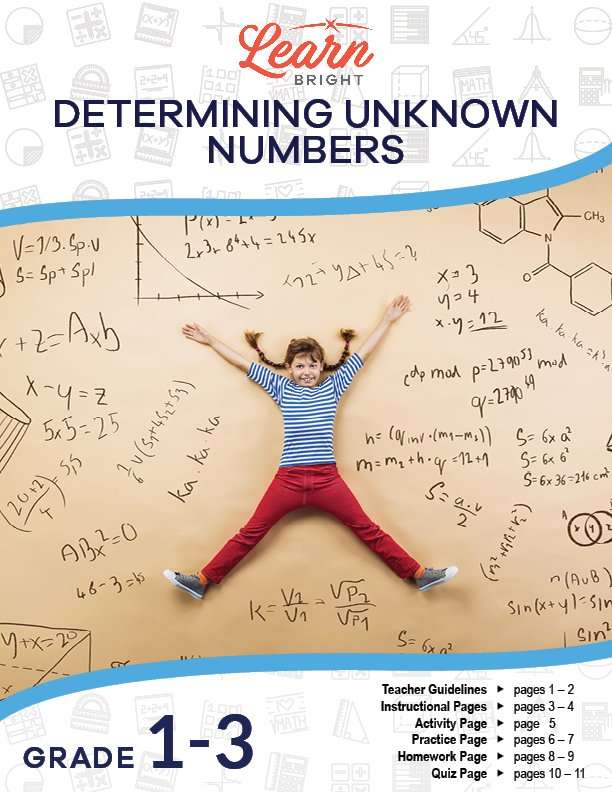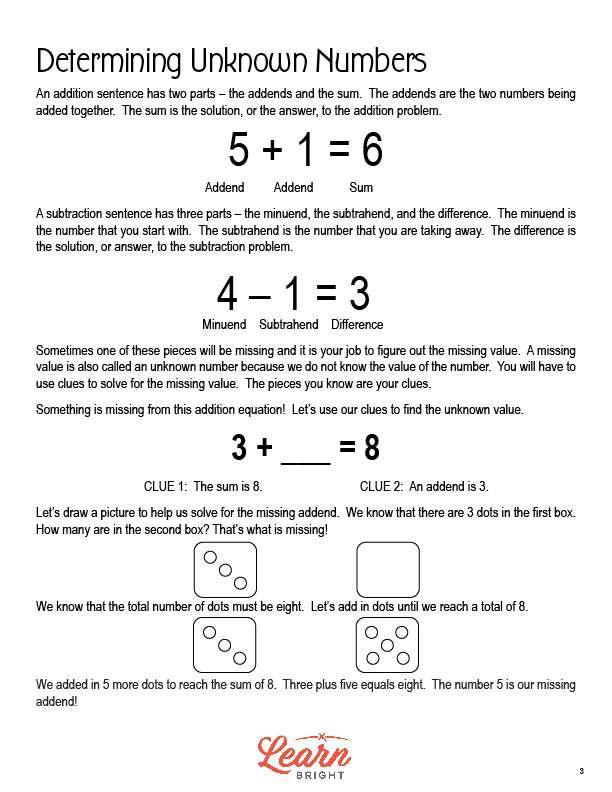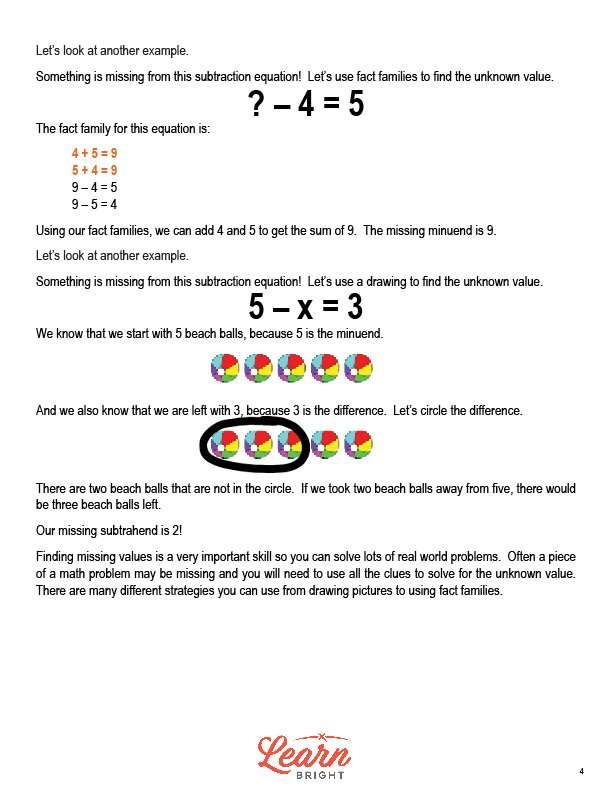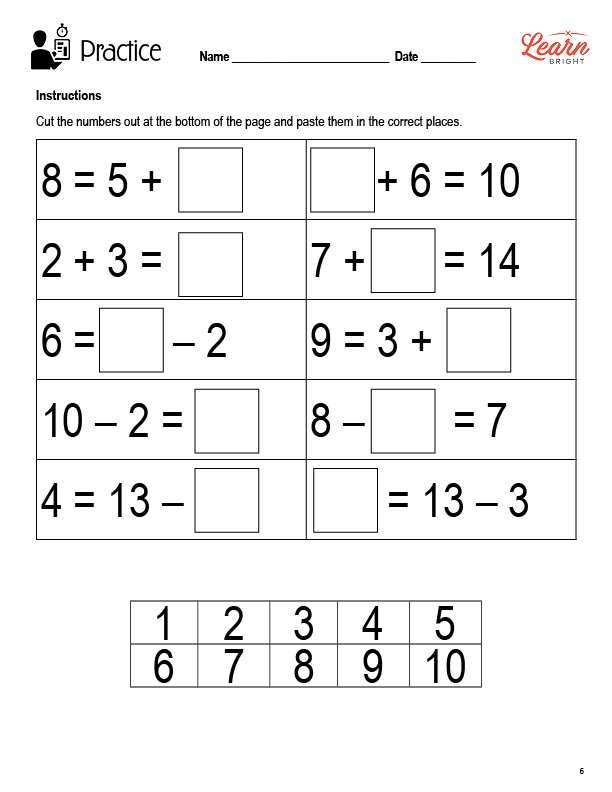Description
What our Determining Unknown Numbers lesson plan includes
Lesson Objectives and Overview: Determining Unknown Numbers teaches students problem-solving skills that can be used to find missing or unknown numbers in addition or subtraction equations. At the end of the lesson, students will be able to determine an unknown number in an addition or subtraction equation. This lesson is for students in 1st grade, 2nd grade, and 3rd grade.
Classroom Procedure
Every lesson plan provides you with a classroom procedure page that outlines a step-by-step guide to follow. You do not have to follow the guide exactly. The guide helps you organize the lesson and details when to hand out worksheets. It also lists information in the blue box that you might find useful. You will find the lesson objectives, state standards, and number of class sessions the lesson should take to complete in this area. In addition, it describes the supplies you will need as well as what and how you need to prepare beforehand.
Options for Lesson
Included with this lesson is an “Options for Lesson” section that lists a number of suggestions for activities to add to the lesson or substitutions for the ones already in the lesson. One optional adjustment to the lesson activity is to have students take turns coming to the front of the class and hiding cotton balls for the class to solve. You could also have your students work in pairs to hide cotton balls from one another in a small group. If you have more advanced students, you could have them work with numbers greater than 10. To help students’ understanding, you could begin the lesson by using a placeholder such as a star or heart in place of the missing addend and then replace the object with a letter to help students begin to get used to solving for a missing variable.
Teacher Notes
The teacher notes page includes lines that you can use to add your own notes as you’re preparing for this lesson.
DETERMINING UNKNOWN NUMBERS LESSON PLAN CONTENT PAGES
Determining Unknown Numbers
The Determining Unknown Numbers lesson plan includes two content pages. Addition sentences have two parts, the addend and the sum. Addends are the numbers that you’re adding together, and the sum is the solution to the problem. In the problem 5 + 1 = 6, 5 and 1 are addends and 6 is the sum.
Subtraction sentences have three parts, the minuend, subtrahend, and difference. The minuend is the first number, the subtrahend is the number that you’re taking away, and the difference is the solution, or answer, to the problem. In the problem 4 – 1 = 3, 4 is the minuend, 1 is the subtrahend, and 3 is the difference.
Sometimes when you’re solving math problems, one of the pieces might be missing and you need to find the missing value. We also call missing values unknown numbers, because we don’t know the value of the number. To find the missing value, you need to use clues—the pieces of the equation that you do have.
Methods for Solving
For example, you might have the problem 3 + _ = 8. We have two clues: the sum is 8 and one of the addends is 3. We might decide to draw a picture to help us solve for the missing addend, which the lesson shows. For this picture, we can draw two boxes and put 3 dots in one box. Then, we add dots to the second box until the total number of dots between the two boxes is 8. We have to add 5 dots to the second box to reach 8 total, so 5 is the missing addend.
We can also solve these problems using fact families, like in the example problem ? – 4 = 5. The fact family for this equation is 4 + 5 = 9, 5 + 4 = 9, 9 – 4 = 5, and 9 – 5 = 4. We can use our fact families to add 4 and 5 together to get 9, so the missing addend is 9.
We can use pictures to solve subtraction problems as well. For the subtraction equation 5 – x = 3, we can start by drawing 5 beach balls, because 5 is the minuend. We know that we’re left with 3, because 3 is the difference. To visualize this using our drawing, we circle the difference (3 beach balls). We’re left with 2 beach balls that are not in the circle, therefore 2 is our missing subtrahend!
It’s very important to learn how to find missing values, because this skill will allow you to solve lots of real-world problems. A piece of a math problem might be missing and you’ll need to use the clues available to you to solve for the unknown value using one of the strategies covered in this lesson.
DETERMINING UNKNOWN NUMBERS LESSON PLAN WORKSHEETS
The Determining Unknown Numbers lesson plan includes four worksheets: an activity worksheet, a practice worksheet, a homework assignment, and a quiz. You can refer to the guide on the classroom procedure page to determine when to hand out each worksheet.
COTTON BALLS ACTIVITY WORKSHEET
Students will work in pairs to complete the activity worksheet. First, they will take some cotton balls and count them. One student will hide some of the cotton balls under a cup, and the other student will count how many are left. They will then use that information to determine how many are hidden. They will repeat this activity and record their answer in the chart on the worksheet.
CUT AND PASTE PRACTICE WORKSHEET
The practice worksheet asks students to cut out the numbers at the bottom of the worksheet and paste them into the correct blank spaces in the equations on the worksheet.
DETERMINING UNKNOWN NUMBERS HOMEWORK ASSIGNMENT
For the homework assignment, students will first circle the two numbers that, when added together, equal another number. They will also look at addition and subtraction problems and fill in the missing numbers.
QUIZ
This lesson also includes a quiz that you can use to test students’ understanding of the lesson material. For the quiz, students will fill in the missing numbers in equations, drawing a picture if needed.
Worksheet Answer Keys
This lesson plan includes answer keys for the practice worksheet, the homework assignment, and the quiz. If you choose to administer the lesson pages to your students via PDF, you will need to save a new file that omits these pages. Otherwise, you can simply print out the applicable pages and keep these as reference for yourself when grading assignments.









